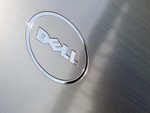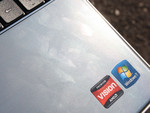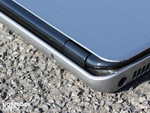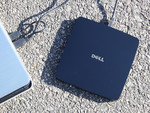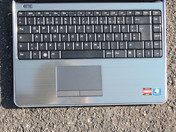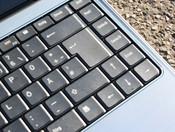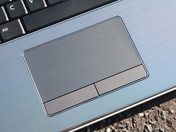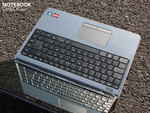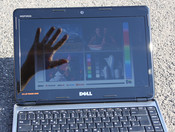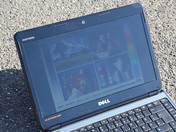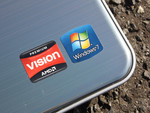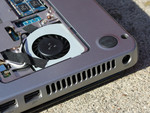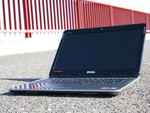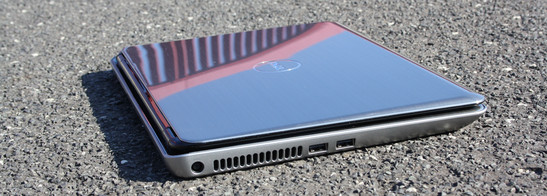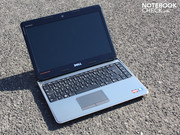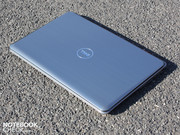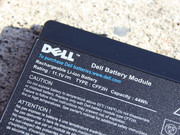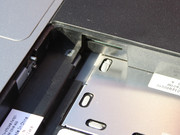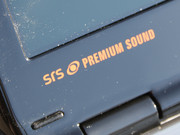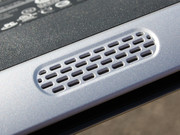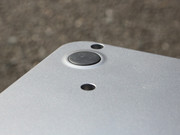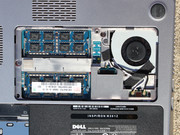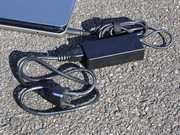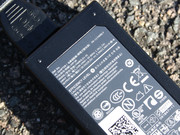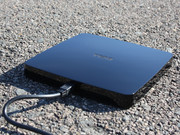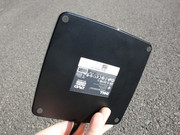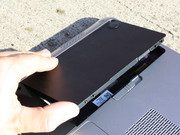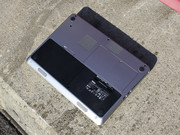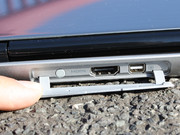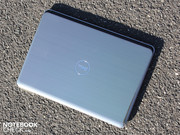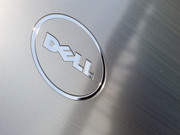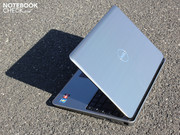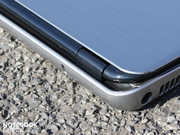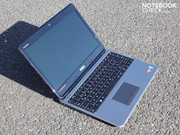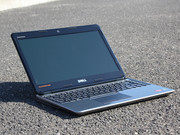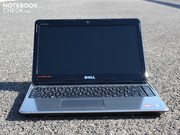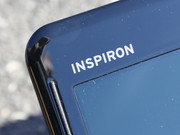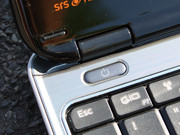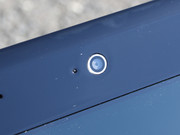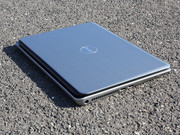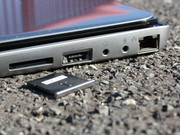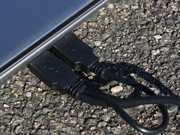Review Dell Inspiron M301z Subnotebook
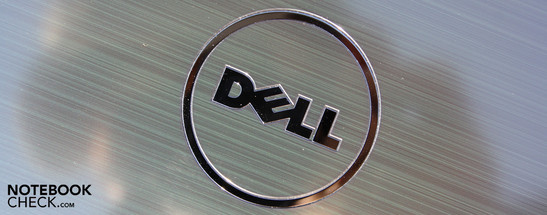
Dell's 13.3 inch Inspiron M301z is the Inspiron 13z's successor from 10/2009. The 13z accomplished the balancing act between mobility (WLAN test: 6:00h) and performance (3100 PCMark Vantage points) with an Intel Core 2 Duo SU7300 (1.3 GHz). The tester could rely on its large 80 Wh battery then, which even made achieving a long runtime possible with the dedicated graphic card, GeForce G 105M.
Times change. Now Dell uses AMD. That's new for the ultra mobility division. Most notebook manufacturers held back on AMD versions in recent years. Especially in subnotebooks for good reason: The K8 core architecture's power consumption was considerably higher than that of Intel Core 2 Duo (ULV/CULV). Timeline-typical battery runtimes of six to ten hours were utopia with AMD systems.
Now AMD has the chance to win notebook market shares again. The first step towards this would be good mobility of the combination Turion II Neo K625 (2x1.5 GHz) and ATI Radeon HD 4225. Will the Inspiron M301z accomplish the same as the Aspire One 521 (Athlon II, HD 4225) in the netbook field? That is to say, the combination of good performance and good battery life. All information can be read in our detailed review.
Case
A look at the pictures of the Inspiron M301z might deceive. The surfaces aren't made of brushed aluminum. but rather of lacquered plastic with a hairline finish. Its shimmering appearance looks great in sunlight. But only until a layer of fingerprints cover every inch of the 13.3 incher. Even the base unit's bottom is covered with a slight glossy coat. Thus, the haptic is smooth up to slippery.
If you rather prefer rubbing your hands on matt surfaces on hot summer days and can't even spell cleaning cloth, you should most definitely look around for another 13 incher. Everyone who can't imagine anything more pleasant than polishing their iPhone might just take a liking to the Inspiron M301z's haptics.
The Inspiron M301z's case has only just two centimeters of height at the front. The base unit increases by a few millimeters towards the back. The manufacturer has really made an effort to design a silhouette as flat as possible. This attempt has been successful, but it's at the expense of the base feet, which are practically non-existing measured with a height of half a millimeter. No feet, no problem? The base unit's lower corners and edges have ground contact at every placing or lifting. Scratches on the coated plastic can thus hardly be avoided. The M301z has a wobbly stance on uneven surfaces. Already a thin pad on the desk provides for a lofty foot.
The case has an adequate, but not perfect torsional stiffness. We couldn't dent the wrist-rest with our hands. The hard disk (left) and the battery (right) are underneath it without any gap. We could warp the base unit slightly with both hands, whereas the construction creaked a bit.
The lid's hinges are indented by a few millimeters, which is supposed to increase their firmness on the base unit. The joint's anchoring actually seems good, but the lid teeters visibly anyway. The opening angle is 135 degrees and we only need one hand for opening.
Connectivity
Whilst most mobile 13.3 inchers rest on their mobility and usually only offer HDMI, VGA and USB ports, the Inspiron M301z tops the competition. It even uses the rear.
The battery is underneath the right wrist-rest, which is why HDMI and a mini DisplayPort can be aligned on the back. The ports are protected by a rubber cover, which is especially beneficial for the clean optics.
Both USB 2.0 ports (left) are complemented by a third as an eSATA/USB combination. If you use eSATA for a fast connection of external hard disks, you'll consequently only have two USB ports available. eSATA in subnotebooks is rare, but very handy for targeted utilization as a mobile entertainment machine. Vast data capacities of movies or music can be transferred or rewritten from an external medium.
Data exchange via network is not that fast. The Ethernet port (RJ45) on the right can only send in Fast Ethernet standard of 10/100 Mbits. A possibly available gigabit Ethernet (switch and other computers) isn't fully engaged with that. At least draft-n is onboard as wireless. Just like Bluetooth (2.1 Dell Wireless 365 mini card), which can be opted out on with a savings of 40 euro.
The M301z doesn't have an optical drive. If you order at Dell, you can add a DVD multi-recorder, GP60N, right away. The drive is powered by the USB port and can therefore be used remote from the mains. For this reason, we have also executed the DVD test via the GP60N. The USB cable has a twin connection at its end for the optimal amperage (USB 2.0 500 mAh). We didn't have to supply the drive with both ports in our tests, though. Unfortunately, the high-gloss case is susceptible for scratches and fingerprints.
Input Devices
Keyboard
The manufacturer uses the entire case width for the keyboard, allowing for large keys with a gap. Enter, shift and arrow keys almost have desktop size. The DEL, HOME, END and PGUP/PGDN keys have found a place on the far right. The keyboard has a distinct pressure point and a sufficient stroke length. A great typing feedback doesn't turn up though, because the stroke is too soft. The high edge below the space key annoyed us. Our thumb constantly hit the keyboard bezel when triggering it.
Dell doesn't leave out hotkeys for media control (play, stop, etc.) and hardware control (display switching, wireless modules, on/off, etc.). They've been placed in the F-key bar as primary or secondary assignment.
Touchpad
The touchpad can fully convince us. It has a diameter of 10.8 centimeters and a good gliding, matt surface. It accepts movements perfectly. The touchpad keys with the quiet click noise and the distinct pressure point give a good feedback. The only downside is the short key stroke length.
It is a multi-touch pad (Synaptics Touchpad V7.5) that recognizes multi-finger gestures. If you don't want to scroll with two fingers, you can simply use the vertical and horizontal scroll bar. These fields aren't marked on the pad and can be disabled via the Synaptics control.
Display
The 13.3 inch HD Ready display has a resolution of 1366x768 pixels. Thus, in this 720p resolution we can watch HD movies without scaling. The so-called True-Life (glare type) LED display is not AR-coated and reflects very intensely at light incidence.
The low contrast of 182:1 has to be reprimanded especially because of the entertainment ambitions. Colors don't look brilliant, black has a light gray tint. The glare-type provides for an optical enhancement of color effects, but it's still not enough for a multimedia display. A multimedia suitable notebook TFT display (also matt) starts at contrasts of 500:1. Even netbooks can occasionally offer this (Sony M11M1E/W), whereas inexpensive starter notebooks currently suffer chronically of a too low image contrast.
| |||||||||||||||||||||||||
Brightness Distribution: 93 %
Center on Battery: 182 cd/m²
Contrast: 182:1 (Black: 1 cd/m²)
The brightness assessment provides another disillusion. 183 cd/m2 is enough for indoors and sheltered places, but it's below average luminosity is by far not sufficient for an auspicious use in sunlight. Good subnotebooks or netbooks perform with 250 to 300 cd/m2. The brightness is very evenly distributed with a deviation of seven percent at most.
Watching a movie in the garden? No problem - if it's dark. But when the sun's out intense reflections and the poor maximum brightness spoil the fun. We constantly had to adjust the viewing angles and the desktop is simply too dim for pleasant viewing. However, annoying reflections of light sources don't only turn up outdoors, but also in the office or during a train journey (sunny side) in unfavorable ambient lighting.
The viewing angles describe if colors or writing can still be clearly seen when looking at the screen from the sides. We didn't have much elbowroom on the M301z's 13.3 inch screen. When the sight deviates upward or downwards (vertical), the colors already bleach noticeably at 20 degrees. We can deviate up to 40 degrees from the center towards the left and right (horizontal). Now the colors invert and the display dims. The narrow viewing angles get annoying when several pairs of eyes look at the display. The second or even third viewer might see a bleached or too dim image.
Performance
The Inspiron M3017 is based on AMD's energy saving notebook platform, Nile (chip set RS880M). The Turion II K625 (2x1.5 GHz) has a 2 MB L2 cache and a TDP of 15 watts.
The 13.3 incher is available in three alternatives. First, with a single core: Athlon II Neo K125 (479 euro). Second with dual core: Athlon II Neo K325 (549 euro) and last with Turion II Neo K625 (599 euro). We have already gotten to know the Neo K125 (12W TDP) in the netbook, Acer Aspire One 521 (10.1 inch). The performance for the netbook class was very good, just as well as the battery life
The ATI Mobility Radeon HD 4225 is integrated in the RS880M chip set. The IGP graphics has an own 336 MB DDR2 video memory, tethered via side port. Up to 256 MB hyper memory can be additionally sidetracked from the abundantly existing four GB DDR3 RAM. This appears to standardly be reserved because the HWInfo shows a system memory of 3839 MB (4096-256=3840).
The 64bit Windows Home Premium is perfect for the K625 processor's 64bit instruction set and for the large DDR3 main memory. The CPU can unfold its computing power better than with 32bits.
How fast does the Turion II Neo K625 compute with its 2x1.5 GHz? Let's take a look at the multi-core benchmark, Cinebench R10 (64bit): 3227 points. (Core 2 Duo SU9400 = 3.266; Dell Adamo). The Athlon dual core Neo K325 (midrange M301z model) reaches 2479 points in this test.
What does this look like when only one core is computing? The Neo K625 (1.5 GHz) is superior to the comparable Intel SU9400 (1.4 GHz) in the single core benchmark Cinebench R10 (64bit). 1561 seconds are better than 1916 seconds.
| PCMark 05 Standard | 3478 points | |
| PCMark Vantage Result | 3017 points | |
Help | ||
The overall system performance is more important than unrealistic, synthetic CPU comparisons. This is influenced by a 7200 rpm Seagate hard disk in the M301z. PCMark Vantage closes with 3017 points. That includes a good HDD score of 3503 points.
At most, comparable Intel notebooks with ULV dual core CPUs and rotating hard disks reach the same PCMark Vantage score. A Lenovo ThinkPad X200t (SL9600, 2x2.13 GHz, 7200 rpm HDD, 4500MHD) "only" accomplishes 3095 points with the higher clocked processor. An Asus UL30A-QX050V (SU7300, 2x1.3GHz, 4500MHD) reaches 2968 points, but a Sony Vaio VPC-Y11S1ES (SU7300, 4500MHD) only 2715 points. Intel's CULV Pentium subnotebooks show clear defeat: Toshiba Satellite T130-14T (SU4100, 2x1.3GHz, 4500MHD) with 2597 points.
The small overview proves: The AMD system's performance can't only keep up with Intel's ULV/CULV, but is even superior measured on the clock rate.
| 3DMark 05 Standard | 2868 points | |
| 3DMark 06 Standard Score | 1297 points | |
| 3DMark Vantage P Result | 189 points | |
Help | ||
Dell builds a 320/500 GB SATA hard disk with 7200 rpm into both 13.3 inch dual core models. The Seagate hard disk (Momentus ST9500420AS) achieves excellent transfer rates in HDTune. 79.7 MB/s in sequential read, 79.1 MB/s at writing. 2.5 inch notebook hard disks with 5400 rpm only reach 60MB/s on average. The high data throughput lifts the system performance, which we noticed in the subjective work speed and in the positive PCMark Vantage result.
The ATI Radeon HD 4225 doesn't bid any graphic performance for computer games. It's rather more about supporting the CPU, for example at video decoding. The HD 4225 has a video decoder (UVD 2) for HD videos (MPEG-2, H.264, VC-1) for this reason. The GPU's DirectX 10.1 capabilities isn't an issue due to the poor 3D performance.
3DMark2006 (1280x1024) finishes with 1297 points. That is twice as fast as an Intel GMA 4500MHD in any case. Intel's Graphics Media Accelerator HD, in current Arrandale processors (Core i3,i5, i7), isn't any faster with 1300 3DMarks06. Due to the strong i3 processor, you could even make the assumption that the Intel HD is weaker than the HD 4225.
We've tried Sims 3 on the Inspiron M301z. This resulted in a perfectly playable 70 fps, but only in minimum details (800x600). As soon as the resolution is set to 1024x768 and the details to medium, the frame rate breaks down to 14.5 fps. A Mobility Radeon HD 4330 would be the minimum requirement in a subnotebook with ULV processor for experiencing a smooth game play (Dell Inspiron 15z, 40 fps).
| Sims 3 | |||
| Resolution | Settings | Value | |
| 1024x768 | med / all on | 14.5 fps | |
| 800x600 | low / off | 69.9 fps | |
Emissions
System Noise
Beside the weak battery, the loud fan is the biggest weakness of the Inspiron M201z. The active cooling already runs consistently with an audible 35.2 dB(A) at light office tasks. It only gets quieter when the active cooling occasionally shuts itself down in longer processor idle states. We can now only hear the noise of the quickly rotating Seagate hard disk with 32.6 dB(A). The fan is almost never disabled on warm summer days, not even in idle mode.
The 13.3 incher isn't roaring loud in office mode, but the fan's characteristic reminds of a small racing engine. The cooling is definitely too loud for the subnotebook's performance. The competition, such as Asus' UL range, serves with 31.2 dB(A) at similar performance (office mode). See Asus UL30 (13.3 inch).
The problem gets even more serious under load. The cooling just doesn't want to calm down already in our Sims 3 test game and rotates with 40.4 dB(A). A stress test scenario, which is unrealistic, lets the racer sprint with a maximum of 43.4 dB(A).
Noise level
| Idle |
| 32.6 / 35.2 / 36.4 dB(A) |
| HDD |
| 32.7 dB(A) |
| Load |
| 43.3 / 43.4 dB(A) |
 | ||
30 dB silent 40 dB(A) audible 50 dB(A) loud |
||
min: | ||
Temperature
Despite the noise, the cooling system doesn't manage the AMD system's waste heat perfectly. The keys and wrist-rest exceed the 30 degree mark easily without heavy load (office tasks). Moist hands on the coated left wrist-rest caused by the waste heat of the hard disk below can hardly be avoided (33 degrees during high activity).
Whilst the bottom provides acceptable temperatures in idle (34 degrees maximum), high temperatures can't be prevented under stress. The base plate heats up to an average of 33 degrees with Furmark and Prime95. 44 degrees are even scraped in the CPU vicinity.
At least the wrist-rest on the upper side always stays pleasant with 26 to 30 degrees. However, the fast rotating Seagate HDD can let the temperature rise to 33 degrees during high activity.
(+) The maximum temperature on the upper side is 38.3 °C / 101 F, compared to the average of 35.9 °C / 97 F, ranging from 21.4 to 59 °C for the class Subnotebook.
(±) The bottom heats up to a maximum of 43.6 °C / 110 F, compared to the average of 39.3 °C / 103 F
(+) In idle usage, the average temperature for the upper side is 30.1 °C / 86 F, compared to the device average of 30.8 °C / 87 F.
(+) The palmrests and touchpad are cooler than skin temperature with a maximum of 29.5 °C / 85.1 F and are therefore cool to the touch.
(±) The average temperature of the palmrest area of similar devices was 28.2 °C / 82.8 F (-1.3 °C / -2.3 F).
Loudspeakers
The manufacturer stresses the quality of both 0.5 W stereo loudspeakers on the product site. The midrange-prone sound is actually fairly balanced and even lets the wrist-rest vibrate slightly. Even basses can be heard in outlines. In comparison to other 13.3 inchers, the sound is impressive. Playing music without headphones won't turn into a hi-fi experience, but we can definitely drown out the neighbor's blaring netbook.
An external sound system can be connected on the left via the 3.5 millimeter jacks. Since HDMI is present, the acoustic output is also possible via a connected TV set. The volume tethered to the notebook (3.5mm line out) is sufficient and static free (audio test - no measurement).
Battery Life
The 44 Wh battery (3740 mAh) already overcasted the M301z before the tests even started. We could only surf for a bit longer than three hours (187 minutes) on the internet. The DVD test was finished after almost two hours (151 minutes). Due to the lack of an internal DVD drive, the movie was played from the included USB drive. The multi-standard burner is powered fully by USB voltage, as it doesn't have an own adapter.
The battery life climbs to 5:40 hours when the Inspiron M301z is in idle (minimum brightness, Battery Eater Reader's test), These 340 minutes are remote from real operating, though.
Is the runtime a beating for AMD? No, because the low capacity of 44Wh can't pry five hours out of Intel subnotebooks either. Thus, the Dell Adamo (SU9400, 3600 mAh) also only achieves 3:33 hours of internet surfing (213 minutes) and even has an energy saving SSD. The Intel comparison device's idle runtime is 5:19 hours (319 minutes) and is therefore a bit shorter than that of the AMD system.
Verdict: The dual core Turion II Neo K625 is energy saving despite a high TDP of 15 watts. The Nile platform runtime is on par with Intel CULV/ULV subnotebooks (e.g. Core 2.Duo SU9400). There will be differences in details, but the device's battery life advocates the competitiveness of the Nile AMD platform.
The M301z has a slightly higher power consumption level than usual for its performance class - in idle and under load. The idle power consumption of the active system is 9.9 watts (minimum brightness, wireless off, HDD on). Comparison devices based on Intel with the same 13.3 inch size are partly a lot more frugal: Asus UL30A (SU7300, 4.4W), or sometimes even a bit more uneconomical: Dell Adamo (SU9400, 11.8W).
The effective power of 30 watts under simple load by 3DMark06 is a slightly increased subnotebook consumption (without dedicated graphic card). The aforementioned, especially economical Asus UL30A is an exception with 21.7 watts. 25 watts are common (Samsung X360, SU9300, 4500MHD). The reason is the lower TDP of Intel's ULV CPUs, which is usually around 10 watts for Core 2 Duo (Turion K625 15 Watt TDP).
While energy savers will be disappointed that the energy consumption is not that low, the standby consumption of merely 0.4 watts should be of interest for them. It even falls to 0.1 watts when the 13.3 incher isn't turned on (both without battery charging).
| Off / Standby | |
| Idle | |
| Load |
|
Key:
min: | |
Verdict
The Inspiron M301z is a potent 13.3 incher based on an AMD platform. Work is easily managed and entertainment applications run smoothly with the fast 7200 rpm Seagate hard disk and dual core Turion II Neo K625. The performance is on a good subnotebook level and is mainly suitable for movies, music or internet. If you want to create content, you'll need the performance of standard notebooks, for example with AMD Phenol or Core i5.
The Inspiron M301z can be connected to TV sets or other displays in many ways with the HD capable ATI Mobility Radeon HD 4225 and two digital outputs (mini DisplayPort, HDMI). The M301z has to struggle with many problems as a subnotebook. The too loud and penetrating active fan for this performance category is even disturbing in simple office work.
Due to the lack of a strong battery (44 Wh), the energy saving AMD system can't show its advantage and ends up with three hours (WLAN test). Compared to Intel subnotebooks with a similarly low battery capacity, it's a competitive runtime. Seen on the whole, many potential buyers will however turn away from the Inspiron M301z and look at an Intel CULV configuration. It tends towards a lower performance, but the battery life of 6 to 8 hours are considerably better (if equipped with a battery with a good/higher capacity).




